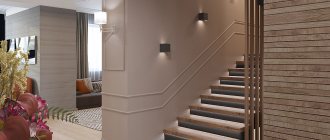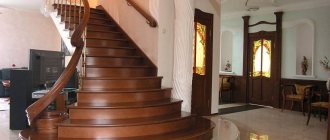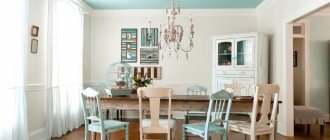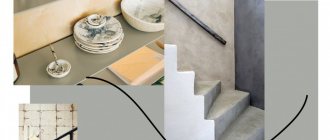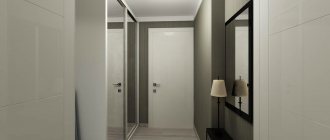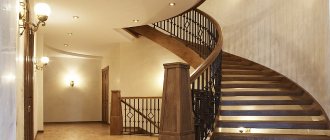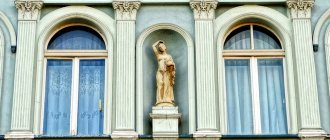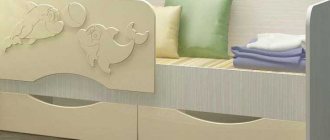Since ancient times, the spiral staircase has attracted attention with its grace and splendor. This is exactly what we meet in ancient castles and admire the elegance of lines, beauty of execution, richness of materials and splendor of interior solutions.
Lednice Castle in the Czech Republic. The spiral staircase in the palace library hall is made of a monolithic piece of wood. Craftsmen carved this staircase by hand over five years. An architectural masterpiece of the German Renaissance. A 20-meter-long spiral stone staircase is located in the open tower of Hartenfels Castle in Germany.
Huge spiral staircase in the Vatican Museum
Spiral staircases have delighted the hearts of people for many centuries, and admirers captivated by their beauty strive to install a spiral staircase to the second floor in a private house.
The twisted staircases that were installed in the princely chambers are not accessible to every average person.
At this stage it is worth leaving emotions and turning to mathematics, geometry and logic.
Spiral staircase in the royal house. Great Britain
First of all, it is necessary to weigh desires and possibilities. That is, what kind of staircase can you afford based on the available space in the room, because there are several basic rules that should not be neglected, so as not to end up with a dangerous object instead of a beautiful and comfortable staircase.
There are many formulas for calculating the correct slope, tread width, riser height, and others. Specialists will make all the necessary calculations and design a staircase that meets all safety requirements. However, the customer must understand the main points in order to make the right choice from the options proposed by the engineers.
Varieties of spiral staircases. a – the steps are supported on the walls and the central pillar, b – cantilever supported on the walls, c – c cantilever supported on the central pillar
Distinctive features of spiral staircase structures
Like all elements present in the interior of a room, radial staircase systems can also have advantages,
and disadvantages, each of which you need to know about when choosing exactly this option for installation in a particular room.
The main feature of spiral staircases is their unusual shape, design and installation methods.
Externally, this structure looks like a petal with rounded edges,
which, after installation, can occupy an area of only 1 m2 and still provide a comfortable transition between floors,
living quarters and attic. This is where all the advantages of using spiral staircases come from:
- Compactness is a determining factor that influences the choice of stairs for small spaces. They do not clutter up the space, and if the room also has low ceilings, then the screw model will help make it visually slightly higher;
- saving space. Most often, a spiral staircase to the second floor is placed in a vertical position around a special support frame, suspended in the air; it does not have inclined straight steps, therefore it takes up little space and does not limit the space in the room;
- ease of installation. Their compact size does not require the creation of a large ceiling opening, which saves floor space on the second floor, attic or attic. In addition, it is possible to install a spiral staircase with your own hands without the use of complex tools;
- availability. The cost of spiral staircase structures is slightly lower than the price of constructing traditional staircases. This is due to the fact that their creation requires fewer consumables;
- versatility. If the spiral staircase is made of durable materials that are resistant to adverse environmental factors, then it can be used on the outside of the building as an additional one. In addition, such a model can be installed either in the center of the room, or against a wall or in a corner of the room;
- originality. A circular staircase is stylish, modern and exclusive, which allows you to add some “zest” to any interior. Which for many owners of private houses is a predetermining factor.
In addition, you can build a spiral staircase with your own hands and not overpay.
It can be made from any material without resorting to the services of professionals,
and the installation of such structures with appropriate preparation lasts no more than one day.
But for this you need to carefully study the drawings of spiral staircases,
get acquainted with the simple principle of their manufacture and understand the nuances of their design and installation.
Despite such an impressive list of advantages of spiral staircases,
they also have a number of disadvantages that must be taken into account when choosing and purchasing for a specific room. For example:
- a spiral staircase can be installed to the attic, attic, or basement in private houses, cottages or apartments, that is, in places with low human traffic;
- not convenient for small children and elderly people;
- The steps of the spiral staircase are not wide enough for the feet of an adult and during a steep climb can become a source of increased injury risk. Therefore, it is impossible to quickly go up and down such stairs, and you will have to be extremely careful all the time. This disadvantage can be compensated for by installing reliable handrails and wider steps;
- each spiral staircase has a trapezoidal shape of steps, which are different in size for the right and left legs, which interferes with normal movement and can also cause injury;
- Regardless of the type of fencing, be it metal or wooden railings, it will not allow large objects to be climbed up the spiral staircase;
- Frequently going up and down a spiral wooden, metal or concrete staircase several times a day can cause slight malaise, dizziness, and nausea. Therefore, on the second floor, attic or attic, to which such a flight will lead, it is better to equip a bedroom or an infrequently used room.
To reduce the risk of injury when using a spiral staircase,
When manufacturing it, it is necessary to strictly adhere to the developed project, comply with all the requirements of GOST and the rules for its installation.
This is the only way you will get a convenient, practical and safe product.
Metal staircase on stringers
It is much easier to make a drawing of a metal staircase if the structure is equipped with the help of stringers. This is due to the fact that you need to calculate the distance for each step and prepare the material that will subsequently be fixed to the base. Stringers are the base (foundation) in the form of a future staircase.
It can be made from different materials and be fixed as required by the room. Of course, to purchase suitable stringers, measurements are still required.
After all, the design must fit the parameters of the space allocated for the stairs. A ladder on metal stringers will help even inexperienced craftsmen complete the installation task.
The main thing is to correctly make drawings of the stairs with a mark of the place where the gangway will be located. And also have on hand the tools and materials necessary to implement this idea in your own home.
Advantages
Design option for a metal staircase
Due to the fact that gangways equipped with stringers have earned their vocation, the positive aspects of this solution are obvious:
- This makes the work process easier;
- Allows you to easily organize the order of actions;
- Such structures are strong and durable;
- Thanks to stringers, even an inexperienced specialist or just a home owner will be able to realize his plans and make them a reality;
- This element allows you to devote more time to details and design experiments that will decorate the staircase project to the second floor.
These are not all the positive aspects of staircases on stringers; each owner of a private house finds his own independent advantages.
Flaws
It is necessary to correctly determine the size of the base for the steps so that the structure fits clearly into the interior. It is not difficult to make such calculations. Simply measure the height, angle and width of the required installation.
Spiral staircase and main varieties
Spiral staircase designs come in a variety of types,
shapes and can be made from completely different materials.
Therefore, there are different types of spiral staircases, many options for their design and decoration.
But, as a rule, they all differ in the following parameters:
- depending on the material that was used to build the system, there are spiral staircases made of concrete, wood, metal, composite materials, or all of these materials in combination;
- by installation location: indoor or outdoor, for location in the center of the room, near a wall, in a corner, which determines the choice of type of fastening of steps and railings;
- intensity of use: main and auxiliary;
- shape: square spiral staircase, round and polygonal;
- type of load-bearing element and method of fastening the steps: supported on perimeter walls and a powerful rack of the internal column, monolithic separately located structure with fastening the steps on the internal column, supported on side railings or a bent bowstring, with the steps supported on the casing and supported by curved railing;
- by design type: spiral modular staircase, prefabricated, transformable and portable;
- depending on the type of steps: open and closed;
- with or without railings;
- depending on the design of the handrails: on brackets, rails, stringers;
- by overall dimensions;
- depending on the style of external design.
According to their purpose, there are entrance, main and auxiliary, interfloor, attic staircase systems and a spiral staircase to the basement.
The choice of material for its manufacture, its dimensions, and design depend on the purpose of the structure.
One of the varieties of spiral staircases for the home is the model
which may partially or completely consist of winder steps.
It is also customary to distinguish the following modifications: curved or curved, quarter-turn and semi-spiral staircases.
As a rule, such systems are most often used as auxiliary and
installed in places with minimal traffic (when going down to the basement or when going up to the attic).
Regarding the choice of material for making a rotary model,
its main structural elements, steps and handrails, then the strength and durability of the staircase structure directly depends on it,
its appearance, functionality and aesthetic design of the room itself,
for installation in which it is actually selected.
Thus, a metal spiral staircase is considered more durable and durable,
but to install it in a residential area, you need to think about its design and decor.
To organize the transition between the basement and living quarters, an ordinary spiral staircase made of metal without decoration or decoration is suitable,
but with a protective coating against dampness, rust and corrosion.
It is better to make the attic staircase aesthetically attractive and consistent with the design style of the room.
which is allocated for its installation.
A metal ladder will not work in this case.
An asbestos-cement or metal pipe can act as the main load-bearing element of the structure,
to which steps are attached by welding or other type of connection.
Sometimes bricks, concrete products,
natural or artificial stone, as well as hardwood.
Railings for a spiral staircase are usually made of wood, metal or a combination of both,
and in the case of ultra-modern design.
High-strength glass or plastic.
These are the most common types of spiral staircases, but there are other, more complex and exclusive models,
which are made only to individual order and exclusively by professional craftsmen.
The main thing to remember is that the spiral staircase must be, first of all, durable,
safe and made from environmentally friendly and non-toxic materials!
Variety of materials
When choosing materials for the manufacture of stairs, it is especially important to relate their properties to the nature of the structure itself. Each material differs in its processing method and appearance. And each element of the flight to the second floor has its own function. Only competent design can combine these two points into a single composition.
Concrete
This is a durable but heavy material. Thanks to the principle of filling a reinforced frame with mortar, concrete structures allow the most daring and unusual ideas to be realized. One of the main inconveniences when using concrete for a spiral staircase is the need to build a frame. However, this feature does not stop some developers and architects. As a result, a spiral staircase can be lightweight with a single curved concrete stringer under the steps. Or monumental, where the steps, bowstrings and handrails are all made of concrete.
A concrete staircase can be either large...
...and quite compact.
Stone
This material is known for its strength and durability. Stairs made of natural stone look expensive and respectable. But, with all its advantages, there is a very significant nuance - its weight and price. The smooth surface of the stone can decorate the steps and make them very durable. Naturally, the supporting frame must be carefully designed for such loads. Only brick, stone, concrete or strong curved metal strings can support the weight of stone steps. Not every floor covering can withstand such a load. Therefore, screw structures made of stone are quite rare.
A marble spiral staircase is expensive, prestigious and requires space.
Brick
This material can play basic and decorative functions. This could be a load-bearing brick column for attaching winder steps. Or a corner niche, as an external support for steps. Any style can benefit from the warm texture of brick.
A spiral staircase made of brick is far from the most popular option.
Tree
Very versatile material. Wood is not as durable as stone, concrete, brick or metal. With proper drying, processing and care, it may well compete with them for space on the stairs. The design of wooden stairs is replete with variety. Handrails, balusters, steps and bowstrings made of wood can add warmth, comfort and add speed, severity and romanticism to spiral staircases.
If you want to make a spiral staircase entirely from wood, you will have to install a massive support.
Metal
Pliable and durable material. The second floor can be connected to the first with a strict, elaborate, massive or openwork metal staircase. Welding, forging, casting - metal is subject to any processing. Solid painting or patina, aging effect or polishing – the metal can be given any “face”.
Metal makes excellent minimalist designs.
Each material for a flight of stairs to the second floor requires a careful study of its properties. The design of unique and elegant staircases is born from a skillful combination of the positive qualities of materials and the functional features of its elements.
Application in the interior
The choice of the type of spiral staircase and the material for its manufacture directly depends on the preferences of the building owners,
on their financial capabilities and on the style of the interior of the room,
into which the created model of the staircase structure should fit.
Since modular spiral staircases are only functional,
but also a decorative element, they are perfect for any interior style.
For example, in those rooms that are designed in a rustic, cowboy or country style,
in classic or “Provencal” styles, wooden spiral staircases will look great,
equipped with massive steps and elegant railings.
Such designs look very beautiful, rich and seem “airy”,
they bring a certain charm to the design of the house and make its interior exclusive.
For interiors in which the Art Nouveau style predominates,
Metal spiral staircases with metal “lace” and balusters are suitable.
For a high-tech or art deco style, it is better to order forged spiral staircases, which, however,
will fit perfectly into any interior if its finishing is made using natural materials.
Spiral staircases for summer cottages are usually made from inexpensive materials,
capable of withstanding simultaneously the high load of seasonal use at home,
and exposure to unfavorable factors: dampness and cold.
In such cases, a spiral concrete staircase or a metal one is more useful - strong and durable structures,
which can even be used outside the building.
And a plywood staircase is not suitable for installation in a country house at all.
In short, for each of the possible room decoration options,
depending on the intensity of its use and different operating conditions, you can choose the appropriate type of spiral staircase.
Its style and type of material from which it will be made.
The influence of styles on the appearance of spiral staircases
The style of a house or apartment is its face, character, mood, atmosphere. But the inner life and spiritual wealth of the owners of the house are revealed not only in the design of the room. A stylish spiral staircase can tell a lot. It depends on the style - whether it will be peppercorn or strawberries and cream in the interior.
Classical and Baroque
Despite some differences between them, a large and monumental spiral staircase in a spacious hall will be appropriate for both of them. A large radius of curvature and adjoining to the wall are its characteristic features. Light concrete stringers and closed risers. Smooth concrete or stone steps. Forged or cast balusters and railings. As a rule, such massive structures should be painted in light colors. Otherwise, they will look heavy.
A spiral staircase in a classic style looks prestigious and elegant.
Castilian and Victorian
These styles can be classified as classic options, but they have their own peculiarity. Railings and steps must be made of dense wood. The color of the wooden elements must be dark. Carved balusters and railings, polished to a shine or tinted with varnish, must be the same color as the steps.
A Victorian-style staircase is a real treat for luxury lovers.
Country
The warmth and airiness of a wooden structure are perfect for spiral passages to the second floor in a country style. The naturalness, light and comfort characteristic of this style should be reflected in the stairs. The absence of exquisite carvings and light tones of natural wood are a sign of good taste in country style.
A country style staircase is simple and cute.
American
Like American culture itself, the spiral staircase in this style is a creative mixture of different styles. Dark wood on the steps and handrails, forged balusters and railings, steps and glass enclosing structures. The screw structure itself can be located anywhere in the room.
American style spiral staircase.
Oriental
The design of a spiral staircase in an oriental style should be bright and enchanting - openwork forged or carved wooden steps, risers, balusters and railings. Often such structures and its elements are made of metal. The lightness, transparency, and almost weightlessness of oriental-style staircases does not mean they are fragile. And metal - forging or casting - is able to maintain its strength even with an abundance of thin elements. The exit to the second floor is a beautiful and courtly design - it is in oriental style. The East is generally a delicate matter.
Spiral staircase in oriental style.
High tech and minimalism
Durable thick tempered glass, fast handrails made of non-ferrous or chromed metal. Steps on rails without the use of bowstrings and stringers. Lightness, light, transparency, simplicity of design and all elements are the hallmarks of these styles. Carpets, massive carved chairs or a patchwork tablecloth will not fit next to such a staircase leading to the second floor. Cramped spaces are also not for such stairs. But a two-level apartment is the perfect place for it.
A high-tech spiral staircase is the choice of modern people who keep up with the times.
The optional presence of steps, original steps, the ability to be placed in different places in the room - all this makes the spiral staircase so versatile. The attractiveness of such designs lies in the rich variety of styles and materials. The texture and color of the walls, chandeliers, paintings, mirrors, curtains, furniture - everything can affect the perception of the stairs in the house to the second floor. The design of spiral staircases, in strict adherence to the features of a particular style, leaves an imprint on the entire room. Beautiful spiral staircases
Creating a spiral staircase
Due to the availability of a variety of consumables on the modern market
and drawings of staircase structures posted on the Internet,
constructing spiral staircases to the second floor, attic or basement yourself will not be difficult,
but only if you have the necessary tools, supplies and desire.
Of course, you can order such a design from a construction company,
and its design in a design studio, but why pay more?
Spiral staircase and space
The design and dimensions of any staircase depend on the location where you want to install it. It must correspond to the size and purpose of the room. Style emerges at a later stage of design. First you need to “fit” the stepped rise into the required space.
Hall
This is the place where guests are greeted. In a traditional English house, this is a large hall with stairs leading to the upper floors, intended for relaxation. Any type of stairs in the hall of a large house should be spacious. Two people should be able to pass on it freely. But the minimum distance of 1200 mm between the railings is not everything. The bending radius should be significantly larger than usual. Powerful winding strings or bowstrings should lead the steps in a large circle. It is possible that they will go along the wall. In addition, a special feature of the spiral staircase in the hall is the free approach to it from both sides. The space underneath can be free so that a piano or jazz band can occasionally greet guests. Shelves with a TV opposite the luxurious sofa will also find a place there. [ot-gallery url=”//lestnitsygid.ru/gallery/vintovye-lestnicy-v-xolle”]
Living room
This room is also the favorite room of the owners and guests. However, the living rooms do not have as much space as the huge hall. But the light, lightness and transparency of screw structures can transform the living room. They will highlight the style and create the mood. [ot-gallery url=”//lestnitsygid.ru/gallery/vintovye-lestnicy-v-gostinnoj”]
Studio apartment
The spiral design is the only type of staircase that fits into the framework of such a room if it has a second floor. The minimum space for the opening is an exclusive property of screw structures. The design and colors of the lower level may differ from the interior of the upper level. But only this type of staircase can effectively unite the floors of a two-level studio apartment. Winding staircases can also fit in small halls, offices or living rooms. In such rooms there is not enough space to place it in the center. It can be located in a corner or niche of the room. But, its design can highlight, emphasize and decorate even a corner. For small representatives of spiral staircases, even the role of an emergency staircase is suitable. [ot-gallery url=”//lestnitsygid.ru/gallery/vintovye-lestnicy-v-kvartire-studii”] The design, dimensions and decorative design of spiral staircases to the second floor depend on the size of the room. The room dictates not only the style, but also the functional purpose of the staircase. Room traffic, interior/exterior lighting, lifestyle - everything has a significant impact.
What to remember?
Any spiral staircase device is convenient to use and performs an aesthetic function.
At the same time, it should be easy to use and multifunctional, harmoniously combined with the overall style of the house.
Fully meet the requirements of future users and comply with all safety regulations, especially
if small children and elderly people live in the house.
And since this type of flight of stairs is a complex engineering structure and requires the presence of two or more flights,
which must be separated by turning platforms or steps.
In their production, a preliminary calculation of the overall dimensions of the staircase itself, the dimensions of its winder steps and the tread width are required.
In addition, in order to achieve maximum service life, reliability and safety of operation of the twisted staircase,
When making it, you should adhere to the following recommendations:
- a design with a free inner edge of the horizontal plane of the steps helps reduce injuries due to foot slipping during ascent or descent along their narrow part. This method of installing a spiral staircase makes it safer to use;
- The most affordable, more reliable and safe option for a spiral staircase is considered to be a model in which the steps are fixed to a load-bearing support and have spiral guards. Other types, which have handrails of a bent-adhesive type and steps fixed without support, are significantly more expensive to manufacture and require complex installation;
- since when moving along stairs, only their middle is most often used, it is better to make it wider - about 20 centimeters, and already at a distance of 15 cm from the central support, the width of the steps can be reduced to a width of 10 cm;
- Remember that narrow steps are inconvenient and unsafe to use!
- when making a purlin, it must be taken into account that the minimum step length should be 15 cm, and the distance between two steps should be 30 cm;
- The manufacture of its steps depends on the purpose of the staircase. If the steps are rarely used, then they can be up to 60 cm long with a diameter of the span itself of 1.4 m. The optimal size is a step length of 80 cm and a diameter of 2 m;
- It is not recommended to make steps on turning stairs, because they can interfere with the full placement of a person’s foot on its surface. And this can lead to your foot slipping and falling;
- when calculating the dimensions of the staircase and drawing up its design, one should take into account the optimal height of the passage, which will ensure comfortable movement of a person along a spiral up to 2 m wide. Therefore, the dimensions of the spiral staircase should be convenient for all its users: both adults and children;
- each of the full turns of the circular staircase must contain at least 11-12 steps;
- The angle of inclination of the stairs itself is also important. And the larger it is, the less space in the room a spiral staircase made of wood or metal will occupy. Acceptable tilt values are considered to be an angle ranging from 23 to 45 degrees. The most convenient to use angle is considered to be from 25 to 35 degrees. If it is more than 45 degrees, then it will be possible to climb such stairs only backwards. And with a slope of less than 23 degrees, nothing will be better than making a spiral staircase in the form of a ramp yourself - without steps;
- a thick-walled round metal pipe with a diameter of about 5 cm is optimally suited as a central support. Even such a minimum diameter will provide the finished structure with the necessary strength. But to create a vintage staircase, you can take a larger pipe, but with fairly thick walls. Such a support will be installed vertically, so the place where it comes into contact with the floor must withstand a colossal load;
- If the installation of a spiral staircase is carried out on a wooden floor, then its vertical post must be secured to the base using anchor bolts and fasteners. You can also secure the base of the structure by pouring concrete using tie rods.
Basic requirements for screw construction
It is advisable to entrust a professional specialist to carry out calculations and develop the project. But if you decide to create a spiral staircase made of metal or wood with your own hands, you must take into account the basic requirements that a reliable, safe model must meet. The main optimal dimensions of the structure are as follows:
- step width 0 20 cm;
- step length – 80 cm;
- distance between steps – 15-20 cm;
- turn size – 12 steps;
- support diameter – 6-8 cm;
- coil height – 170-200 cm;
- opening diameter on the 2nd floor – 2 m;
- the total number of steps is odd.
This data can be used as a guide. Depending on the type of design and operating features, they may vary. For example, if the stairs do not have to be used often, the length of the steps can be 50-60 cm. If it is necessary to create a full-fledged structure that allows you to conveniently carry even large items, this figure can be increased to 3 meters.
The distances between steps can be calculated individually. The main guideline for this is human height and optimal step length. If there are children or elderly people in the house, the distance between the elements should not be large. This creates a risk of injury.
Stylish spiral staircase without railings
Modern designs of spiral staircases do not always have railings. Their absence gives the building a stylish, interesting look, provides lightness to the interior, and creates a feeling of spaciousness. But such a solution cannot be used if the stairs will be used by children and sick people.
What is the procedure for creating a screw structure with your own hands?
Algorithm for creating a spiral staircase to the second floor with your own hands:
- choosing the type of flight of stairs;
- carrying out calculations taking into account the exact dimensions of the opening in the ceiling, the width and inclination of the planes, as well as the thickness of the materials used;
- designing a spiral staircase and creating a scale drawing of the future structure. At this stage, it is important to take into account the structure of the first and second floors, indicate the place where the staircase structure needs to be installed, and where the opening between the floors should be made;
- installation.
Do-it-yourself metal or wooden spiral staircase is not possible
without precise measurements and calculations of its main structural elements.
Therefore, you need to calculate the parameters of its individual parts extremely carefully.
Otherwise, even the slightest mistake can lead to discomfort and an increase in the level of
injuries during operation of a prefabricated or monolithic spiral staircase.
And the assembly and installation of the structure itself must be carried out strictly according to the outlined diagrams.
To ensure that the stairs are comfortable, easy to use and safe for ascent and descent.
It is recommended to follow all recommendations and rules at all stages of its creation,
developed and tested by experienced specialists.
Combined screw structures in the interior
Combinations of various materials are often used to create screw structures. For the most part, metal elements are used in the form of supports and railings. Balusters are made from steel and aluminum, artistic cast iron forging is used, etc. Staircases that combine metal and wood or glass elements look impressive.
The choice of combinations largely depends on the interior design style. Combination of wooden steps:
- with elements of artistic forging are used in classics;
- with openwork metal fences are used in Art Nouveau and Provence;
- with laconic steel railings complement minimalism.
Combination of metal and wood in a spiral staircase
An ideal option for high-tech is a spiral staircase with supports, railings made of stainless or chrome steel and steps made of plexiglass or triplex. These designs look original and give the atmosphere lightness and spaciousness.
Instead of expensive wood, elements made of slabs and plastic that imitate natural materials can be used in the manufacture of structures. The decor of the steps uses laminated film, artificial veneer, and polymer tiles.
The combination of chromed steel and glass gives lightness to the atmosphere
Calculation of a spiral staircase
Regardless of the type of structure, wooden and concrete spiral staircases
equally require accurate calculation of all their parameters.
Let's look at an example of calculating the structure of a metal staircase with your own hands,
in which a steel tube 5 mm thick and 6-8 cm in diameter will act as a support.
In this case, a steel angle will be used to weld the consoles,
and for arranging the steps - solid wood.
Since the spiral staircase to the attic or to the second floor is a regular circle,
then its diameter must correspond to the size of the opening, the circumference of which is determined by the formula:
L=2?*(2R/3)*n,
where L is the circumference, R is the outer radius of the staircase console, 2R/3 is the radius of movement, Y is the rotation of the structure, an angular value that demonstrates the difference in height between the steps of a spiral forged staircase, n is the length of one step, which is the difference between the radius opening and outer radius of the support pipe.
The angle of inclination of the opening is calculated by the formula:
Y=Y: number of steps.
We calculate the tread width using the formula:
W=2R*sinY,
where W is the width of the step, R is the outer radius of the staircase console, Y is the angle of inclination of the stairs. The most convenient to use are spiral staircases with a tread width of 20-30 cm.
Knowing the width and angle of the step, we calculate the largest tread width:
W1=R*sinY,
where W1 is the maximum tread width.
In order to determine the number of steps, it is necessary to divide the height of the entire opening from the floor of the first floor to the level of the second by the height of one step.
The height of one step should be within 15-20 cm - the most optimal size for an adult.
Tilt angle
The overall angle of inclination of the stairs should be between 20° and 36°. This standard is considered the most comfortable, practical and safe for stairs that are frequently used. The disadvantage is that such a staircase will take up a large area in the house. If your room does not allow this, then you can limit yourself to an angle of up to 45°; such a staircase will take up less space, but will be steeper; you need to walk on it more carefully. In no case should this threshold be exceeded; stairs with a large angle of inclination are used only as stepladders or for access to the attic, warehouse, or basement. So if you don’t want to turn your stairs into a ladder, then it’s better to adhere to safety recommendations.
A visual hint for calculating the angle of inclination of the stairs and determining the required tread width
Durable metal stairs in a home for the whole family
In any house with several floors, a staircase is a necessity.
It must fit into the overall interior, and also perform the function of lifting and moving between floors.
Today, many owners prefer to install a metal staircase in their home. A private house often has enough space to install a large and beautiful staircase.
A metal staircase installed in a house must be durable and safe
There are some types of metal stairs that are installed in the house:
- Modular design is popular for its versatility and variety of style solutions. Most often, they are prefabricated. This staircase can be assembled independently, without the involvement of a specialist, in a matter of hours.
- The spiral staircase structure is installed in narrow rooms with a small area. May have a square or round shape. Easy to install, no cracking. Has a low cost.
- The metal staircase is equipped with a platform and a flight. This type of staircase can be installed in any room, regardless of the size of the area. It is stable and safe.
- The combined type is made to order according to an individual drawing, for example at Epicenter. It has a special design; it will be expensive to fix something in the future. Installation depends on the complexity of the project.
- Winder staircases have rotating parts of flights on which winder steps are installed.
In order for staircase structures to be beautiful and safe enough, it is necessary to supplement them with railings. Forged models will look impressive. They catch the eye with their smooth lines and openwork patterns. For simpler ideas, cold forging from ordinary iron rods is suitable. A more expensive option is obtained by manufacturing the supports using hot forging. Handrails made of aluminum or stainless steel also look great. For greater effect, metal can be combined with plastic or glass railings.
How to make a metal street staircase with your own hands
Making a street staircase yourself is a feasible task for a person with skilled hands. However, we are talking about installing a simple structure. For example, consisting of metal profiles and reinforcing bars. It is better to entrust the production and installation of multi-flight or spiral staircases to professionals.
The work process can be divided into several stages:
- Carrying out the necessary measurements and calculations;
- Preparation of drawings and tools (grinder and welding machine);
- Manufacturing of staircase parts;
- Installation of the base and steps, the connection of which is carried out by welding;
- Grinding and processing of the finished structure.
You can make a metal staircase yourself if you make the calculations correctly. You can read how to do this for different types of stairs on our website:.
When making calculations and preparing drawings, established standards must be observed. The size of the tread can vary from 25 to 40 cm, the width of the step must be at least 90 cm. The size of the riser is from 12 to 20 cm.
Do not forget about the inclination of the steps by 2 - 3 degrees. Otherwise, water will regularly accumulate on the surface, making climbing the stairs unsafe. In addition, the structure should be installed on the foundation of the house. This arrangement eliminates the possibility of its displacement.
What types of metal stairs are there?
The design of staircases in a house can be different, but each of them is worthy and is often chosen by the owners of private country houses. The designs of metal stairs are:
| Screw | Such gangways will help save maximum usable space in the room. The steps will favorably emphasize the sophistication of the design and add a spark to the overall picture of the interior space. The only thing that can stop you is the difficulty of implementing the drawing yourself. Without special skills, a person cannot cope with the measurements required for such a complex structure. And also the direct process of installing stair structures requires some skill and skill. Knowing all the features of a spiral staircase, a person will be able to realize the idea of installing such a structure on a gangway. After the implementation of the plan, the interior will immediately sparkle with new colors. |
| Marching | This option is most often used to implement the idea of installing staircase structures. For such an array it is easy to draw a diagram even for those who have never encountered such a task before. Marching stairs can be straight, leading to the second floor or with turns (this helps to save space). Measuring the parameters required for drawing any of these types of gangways is very simple. It is enough to have the necessary tools and devices at hand. Direct installation of the structure is also elementary. You just need to follow the step-by-step actions that you can read about in any relevant literature. |
| Mounted | There are structures leading to the second floor that are supported on the wall. No supports are installed under such structures. The main load-bearing and load-bearing structure is the wall. Therefore, before proceeding, you should make sure that the walls are strong and ready to withstand such a high load. If yes, then you can safely equip a hanging metal staircase. Such a staircase will help save space and make the style of the room elegant. |
Stages of creating a staircase with your own hands
Making a metal staircase with your own hands is quite simple, and it doesn’t matter whether the structure is being built on the porch or on the second floor, only the type of structure changes. The first thing you need to do is decide on the type of building, depending on its purpose.
And then just follow the instructions clearly and carefully think through your steps.
Calculations
If you ordered a design calculation from a special company, then such organizations use computer programs to create the design. In such a program, parameters can be easily changed, and after the customer approves the final version, the computer produces drawings.
If you did not contact a design company, but decided to complete the drawings yourself, then it will be a little more complicated. Let's consider performing calculations for the simplest design - a straight single-flight one.
There are standard requirements for calculations
Typical requirements:
- The height of the steps should be 17-18 cm.
- The optimal width of the stairs for private houses is 90 cm.
- The minimum depth of steps is 27 cm.
- The step of the staircase structure is 60-65 cm, this includes the height of the step and riser.
- The optimal angle of inclination of the steps is 30-45°.
- The fence must support a weight of about 100 kg.
- The minimum distance between fence posts is 15 cm.
In addition to the standard requirements, to manufacture a straight single-flight structure, it is necessary to perform the following calculations:
- Fixture length. To do this, you need to calculate two sizes. The first is the distance from the beginning to the end of the stairs (meaning the distance from the first floor to the second). The second is the height between them. You got two numbers. Each one must be squared and then folded. Next, extract the root from the resulting number.
- Number of steps. To do this, it is necessary to divide the resulting length of the device by the selected step height. The optimal height is indicated in the standard requirements.
- Depth of steps. It is necessary to divide the length of the staircase by the number of steps and see that the resulting figure meets the requirements; if necessary, change the dimensions in the previous paragraph.
The resulting dimensions are needed to determine the amount of material.
Preparatory work
Before starting work, you need to prepare all the necessary equipment. Regardless of the type of structure chosen, some of the frame elements will be connected to each other by seams, so the first and main device when constructing a structure is a welding machine. If you have never done welding before, use a manual inverter; it is easier to use. If you have experience, then you can use any other device that is suitable for welding the metal of your choice.
You should also prepare a mechanical saw, an emery wheel and a grinder. If you want to make a metal staircase with wooden steps with your own hands, then you will need a clamp and an electric drill, as well as a circular saw and self-tapping screws.
An important stage of the preparatory work is the creation of a project for the future structure. You can either order it from a specialized company or do it yourself using suitable drawings from the Internet. Based on the project, you can calculate the required amount of reinforcing steel, metal profiles, and sheet metal. Before starting work, you need to practice welding on unnecessary metal blanks.
Manufacturing of blanks and parts
When the calculations and preparatory work are completed, it comes to making the blanks. We will need to make stringers; for this we need a square profile pipe. The role of support will be performed by iron corners. We will make steps and risers from sheet steel 4 mm wide.
Installation of a metal frame
After completing the calculations and manufacturing the main parts, it is necessary to begin the first stage of frame installation. The simplest staircase design is based on a channel placed on its side, the dimensions of which are 8-10. If you want to finish the staircase, you need to prepare sheet metal or wooden boards for this.
To make your own metal porch, when covering the stairs, it is recommended to use non-slip materials, such as corrugated metal sheets. Railings and fences for this design are made from angle steel. To make supports for the stair treads, reinforcing steel should be prepared.
Next, let's look at step-by-step instructions on how to make a metal staircase with your own hands:
- The first stage will be cutting the reinforcement into fillets. These are special supporting devices that are placed on the beam. The required number of fillies and their sizes are selected according to the design documentation of the structure.
- The next step is to weld the mounting containers to the side of the fillet where the step will be placed.
- Then we weld the fillets to the channel; they can also be secured with bolts. At this stage, pre-made markings will help you.
- Next, attach the next channel to the beam with the fillets attached to it and, if necessary, correct the markings.
Important! If you are going to build an ordinary staircase with a meter width with your own hands, then a few stringers or bowstrings will be enough.
We strictly follow the instructions for creating a staircase.
If a larger structure is planned, then there must be at least three support beams.
- The next step is to assemble the metal staircase using welding.
- Then treat the material with a primer and wait until it dries completely.
- Treat the metal with a special anti-corrosion compound.
- Place the building on supports. As a support, you can use metal corners attached by welding to beams or channel racks.
- The structure is ready, all that remains is to sheathe the steps.
Frame paneling with wood
Various materials are used to cover metal stairs. The most popular is finishing stairs on a metal frame with wood:
- The first thing to do is mark the places on the steps where the bolts will be placed. The pitch should be 15 cm, and the distance between the mounting holes and the end edges should be 2 cm.
- Next, the plywood backing is attached. Fixation is carried out using a special glue that has a filling effect. This composition allows you to eliminate minor imperfections; it does not wrinkle after drying.
- The last step is to fix the wooden overlay on the tread; for this, clamps, screws or bolts are used.
Installation of railings and fences
Most often, wood and metal are used to make railings, less often stone, glass, and PVC.
When making a wooden staircase, the following rules must be observed:
- Fastenings should be made with self-tapping screws, which are covered with wooden plugs.
- The handrail is fixed to the rack with screws. Tenon joints are considered more reliable. Such spikes are lubricated with glue before fastening.
- Filling is carried out from bars or racks.
- If a bowstring is used, the fastening can be done using pins. They are glued into the lower part of the support. After this, the balusters are inserted into the sockets.
- If stringers are used, then installation is carried out on the steps.
If you have chosen metal railings for the fence, then assembly is carried out as follows:
- Metal fasteners are mounted with bolts or welding.
- First, a 10 cm long hairpin is screwed into the lower part of the post and balusters.
- Then the upper part of the rack is installed, it is screwed into the step, and the pin is removed. These pins serve as a guide for marking.
- Next, holes are drilled according to the markings for attaching metal elements.
- Then the supports are screwed into the treads.
- The posts are trimmed.
- The handrail is attached.
A metal staircase can be equipped with any type of fencing, since metal combines well with various materials. These can be ordinary vertical posts, glass, hand-forged elements, and the structure can also be equipped with throws.
